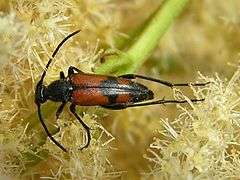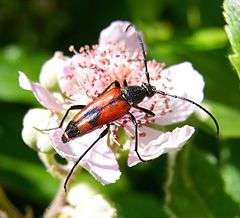Stenurella bifasciata
| Stenurella bifasciata | |
|---|---|
| | |
| Stenurella bifasciata, female | |
| Scientific classification | |
| Kingdom: | Animalia |
| Phylum: | Arthropoda |
| Class: | Insecta |
| Order: | Coleoptera |
| Suborder: | Polyphaga |
| Family: | Cerambycidae |
| Genus: | Stenurella |
| Species: | S. bifasciata |
| Binomial name | |
| Stenurella bifasciata Holzschuh, 2006 | |
| Synonyms[1] | |
| |
Stenurella bifasciata is a species of beetle in the family Cerambycidae.[2]
Etymology
The Latin species name bifasciata means with a double fascia.
Subspecies
- Stenurella bifasciata intermedia Holzschuh, 2006
- Stenurella bifasciata lanceolata (Mulsant & Rey, 1863)
- Stenurella bifasciata limbiventris (Reitter, 1898)
- Stenurella bifasciata nigrosuturalis (Reitter, 1895)
- Stenurella bifasciata safronovi Danilevsky, 2011
Distribution
This species is present in most of Europe, in the East Palearctic ecozone and in the Near East (Albania, Austria, Belarus, Belgium, Bosnia and Herzegovina, Bulgaria, China, Corsica, Croatia, Czech Republic, Estonia, France, Georgia, Germany, Greece, Hungary, Iran, Italy, Kazakhstan, Latvia, Lebanon, Lithuania, Luxembourg, Macedonia, Moldova, Montenegro, Poland, Portugal, Romania, Russia, Sardinia, Serbia, Sicily, Slovakia, Slovenia, Spain, Switzerland, Syria, Turkey, Ukraine).[4]
Habitat
These longhorn beetles live in meadows and slopes in foothills and valleys.
Description
Stenurella bifasciata can reach a length of 6–10 millimetres (0.24–0.39 in).[5] Head, antennae, pronotum and legs are black. Pronotum is slightly punctured. Elytra are yellow brown in the males, while in the females they are red, with a widely darkened elytron's suture, black apices and a black heart-shaped or rhomboid marking, sometimes missing in the males. The last three abdominal segments are usually red. The eleventh (last) antennal segment is longer than the tenth.
Biology
Life cycle last 2 years. Larvae develop in dead wood of deciduous trees.[5] They mainly feed on Pedunculate Oak (Quercus robur), Fig (Ficus carica), White Willow (Salix alba), Dog-rose (Rosa canina) and Spanish Broom (Spartium junceum).[1] Adults can be seen from May to September.[5]
Gallery
- Female of S. bifasciata
- S. bifasciata
 S. bifasciata feeding on Aruncus sylvestris
S. bifasciata feeding on Aruncus sylvestris S. bifasciata feeding on Rosa canina
S. bifasciata feeding on Rosa canina
External links
References
- 1 2 Biolib
- ↑ Bezark, Larry G. A Photographic Catalog of the Cerambycidae of the World. Retrieved on 22 May 2012.
- ↑ Catalogue of life
- ↑ Fauna europaea
- 1 2 3 Cerambycidae